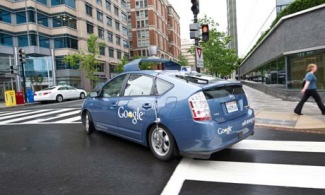
By John Naughton
Almost without noticing it, our world crossed a significant threshold last week. Jerry Brown, the governor of California, signed into law a bill that will allow driverless cars on to his state’s roads from 2015. Insofar as most people noticed this event at all, they probably sniffed derisively. For some, it’ll be seen as an example of techno-hubris – “flags on the moon stuff” – as one of my acquaintances put it. For others, it will be seen as yet another confirmation of the proposition that the continental United States slopes gently from east to west, with the result that everything with a screw loose rolls into California.
Governor Brown signed the bill at Google’s HQ in Mountain View. This was good PR on his part, but it also made sense because Google has led the charge into autonomous (aka driverless) vehicles. For several years, Toyota Prius hybrids that have been specially adapted by the company’s engineers have been driving the roads of California. To date, they have logged 300,000 miles with only one accident – caused by a human-controlled car that ran into one of them. And they have now logged 50,000 miles without a human having to take the wheel.

